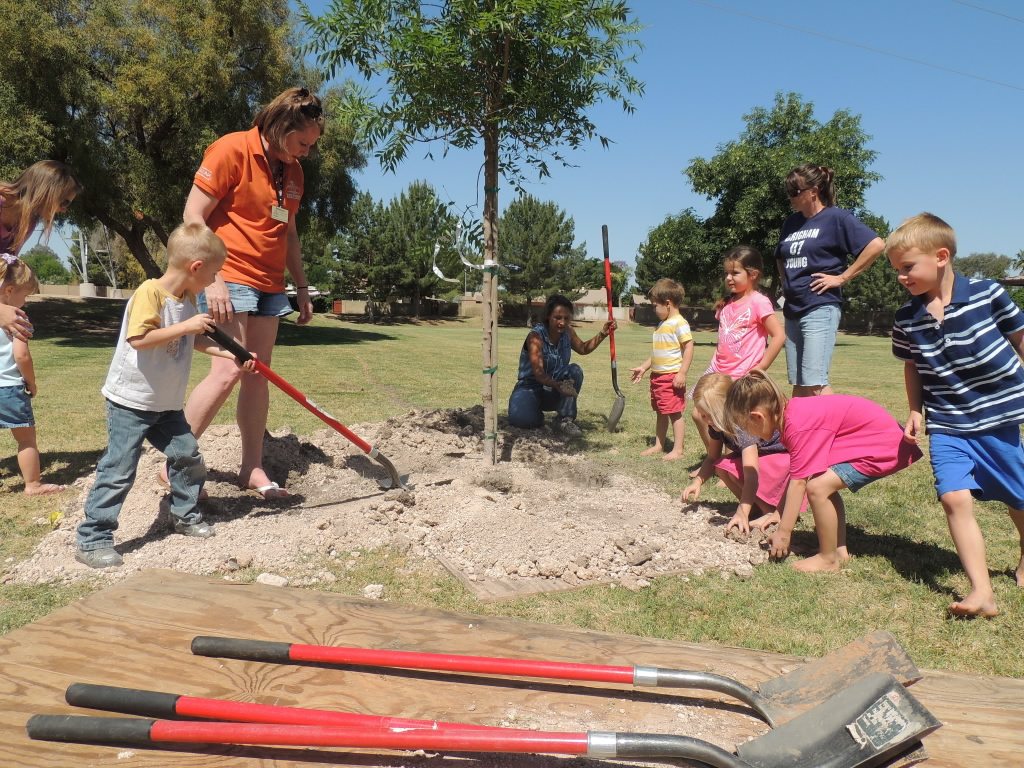All about Arbor Day
April 27 is designated as National Arbor Day, a holiday set aside to celebrate the significant role trees play in our lives and our environment. It is also a day to promote the planting and care of trees. The founder, J. Sterling Morton, had the idea of setting aside a special day for tree planting. As a result of his efforts, more than 1 million trees were planted in Nebraska on the first Arbor Day some 146 years ago. Today, this special day is now observed in all 50 states, Puerto Rico, and some U.S territories. The dates of the celebrations that take place in each location are based on when it is most appropriate to plant in that geographical area.
Benefits of Trees
So why should we celebrate and plant trees? In addition to being beautiful, trees have many benefits. Here are just a few reasons to consider planting a tree when adding or replacing plants in your landscape:
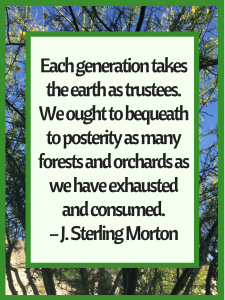
- The shade of a well-placed mature tree can lower the surface temperature of your home and reduce your energy use by as much as 40 percent. And since energy generation requires significant amounts of water, reducing your energy use also reduces water demands.
- Trees produce oxygen and help to clean the air by removing airborne particulates and other pollutants.
- Trees can help prevent water pollution by alleviating stormwater runoff. The canopy of the tree collects the rainwater and it then runs down the trunk and into the ground. This prevents the stormwater from carrying pollutants into our waterways. Trees can also help alleviate soil erosion by slowing runoff and holding soil in place. These benefits happen in well-forested areas and in our cities.
- Trees attract and provide habitat for wildlife, including birds, bees, bugs, and butterflies.
- Homes landscaped with trees sell faster and have higher property values as compared to homes without trees.
- Trees provide food for both humans and wildlife.
- Trees can create barriers to muffle or diffuse sounds and camouflage unsightly views.
- In many places around the world, trees are nature’s calendar, marking the changing of the seasons.
- Planting trees at a community event, such as Arbor Day, can improve engagement among residents and help strengthen neighborhoods.
- Trees can create jobs, such as selling harvested fruit, landscaping design and maintenance, and skill-based jobs related to turning the wood into products.
Some of Water – Use It Wisely’s Favorite Desert Trees
We have established that trees can benefit our lives and the environment in many ways, but it’s also important to choose the right ones for your climate. These desert-adapted, water-thrifty trees will add color and beauty to your landscape and help to keep your water bill in check when maintained and watered properly.
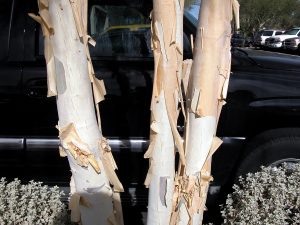
Palo Blanco, Acacia willardiana (reclassified as Mariosousa willardiana)
The Palo Blanco is a weeping and graceful tree that is covered with the most interesting papery, peeling bark. This tree works great in small spaces growing about 20 feet tall but only 10 feet in width. The wispy branches must be just the right size for hummingbird feet as they love to perch and rest in these trees. Try planting this tree in clusters of three or five if you have more room in your landscape. And, best of all? It’s a Sonoran Desert native.
Anacacho Orchid Tree, Bauhinia lunarioides
The small native Anacacho Orchid tree is more shrub-like but works well in small yards. It grows to about eight feet tall and four to six feet wide. With butterfly-shaped leaves and small white clusters of orchid-shaped blooms, you won’t be disappointed with this tree native to southwestern deserts. While related, don’t mix it up with the much larger purple Hong Kong Orchid Tree that is native to China and has problems with our cold winters.
Palo Brea, Cercidium praecox (reclassified as Parkinsonia praecox)
Another Sonoran Desert native, the Palo Brea is one of the most strikingly handsome trees to have in the landscape. They do get to be good sized, reaching 25 to 30 feet tall and 25 feet wide, so make sure you have space for them to grow. Bright yellow blooms decorate the canopy and the ground in late spring. Leave the flower mulch as it’s not only beautiful, but it’s also good for the tree. And while the blooms bring beautiful color to your landscape, it is the trunk and bark that catch your eye. Here is an eloquent description by southwest landscape book author, Mary Irish, “The bark, a deep ocean green, is so smooth it resembles a dancer’s leotard clinging to the winding branches.”
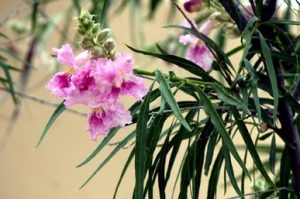
Desert Willow, Chilopsis linearis
The Desert Willow is a lovely tree with big, trumpet-shaped flowers. While the flowers are typically shades of pink, you can also find many other color options that range from white to deep purple. Hummingbirds, songbirds, butterflies, and other pollinators are attracted to this tree during its summer bloom period. There are a lot of cultivars (a plant variety that has been produced in cultivation by selective breeding) available for this tree at your local nursery that will determine the overall form and branching structure of this tree. It does lose its leaves in winter, but we like having the sun shining through during that time.
Feather Bush, Lysiloma microphylla v. thornberi (reclassified as Lysiloma watsonii)
If you want to add lushness to your yard, then the Feather Bush is the tree for you. Also called Desert Fern, this tree is dark green and soft with no thorns. Growing about 15 – 20 feet tall and about 15 feet wide, it is super easy to care for, though flowers and seed pods do create a small amount of litter. It’s a great tree to provide a graceful and even tropical effect to your landscape, yet it’s also extremely heat and drought tolerant.
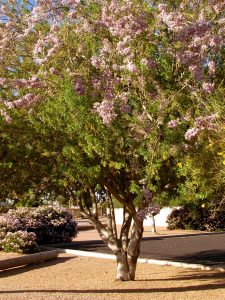
Ironwood, Olneya tesota
The Ironwood is yet another handsome tree that lends character to the landscape and is native to the Sonoran Desert. This tree typically has great branching structure and grows to about 25 to 35 feet high and 25 feet wide. Dusty lavender blooms appear in late spring and songbirds will appreciate this tree in your landscape. And while this tree is thorny, it has many positive traits that make it a great choice: it grows slowly and requires little pruning; it is long-lived and slow growing; and, it is one of our toughest desert trees.
Velvet Mesquite, Prosopis velutina
There are many mesquites to choose from, but the Velvet Mesquite is a good one to look for as it can handle nearly any soil type, is water thrifty, and tolerates full sun. This graceful tree is native to Southwest deserts and is excellent for attracting wildlife. The reason it is not selected more often is that it does have small thorns — well, sometimes they’re large when the tree is young, but that’s because it’s protecting itself. It has very little issue with blowover like the South American ‘thornless’ varieties do, which makes it a good choice for adding stability and beauty to your landscape. Growing about 25 feet high and wide, it provides a shady canopy that you’ll be happy to have during the heat of the summer.
Did you know that up to 70 percent of water use is outdoors? That’s why we love desert plants and feature them each month. It’s still a great time to plant, and you can learn more about desert trees and other plants on our Arizona Low-Water-Use Plants page. Visit our page on Choosing and Planting Low-Water-Use Plants for tips on plant selection and how to plant properly.
Also, be sure to read through all of our featured Plant of the Month blogs!
You can also learn more about these and other great desert plants in Arizona Municipal Water Users Association’s Landscape Plants for the Arizona Desert plant database.
To find a nursery in your area, visit the Arizona Nursery Association’s Plant Something Campaign.


